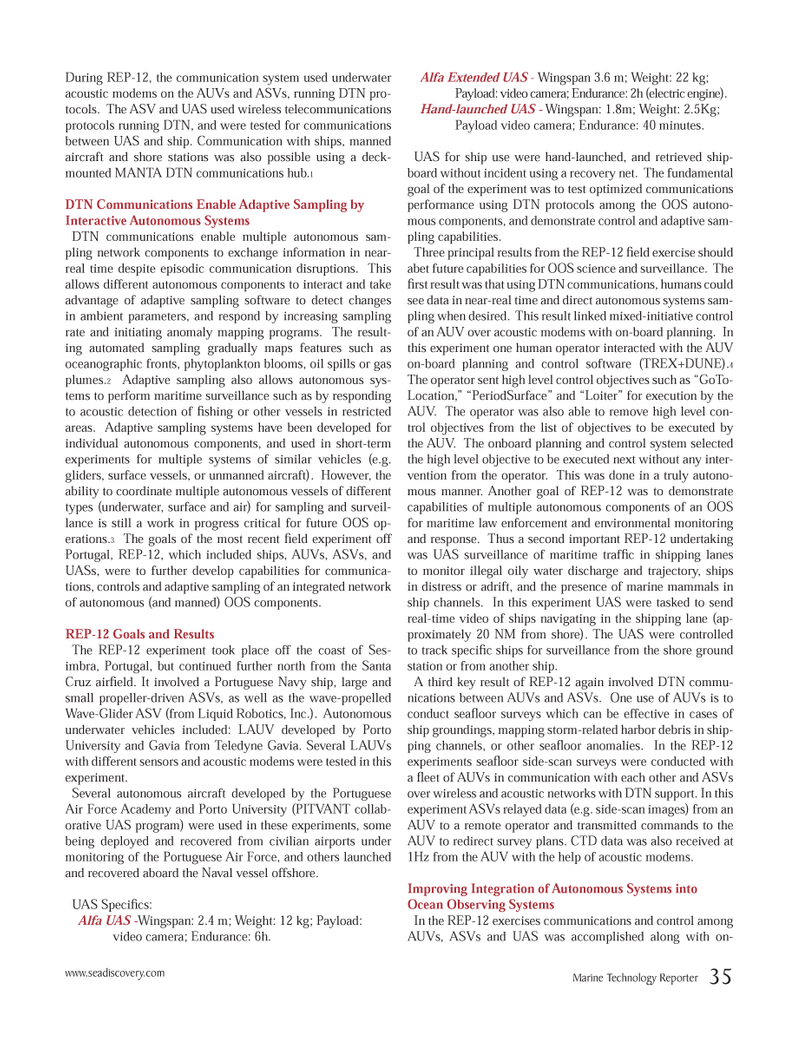
Page 35: of Marine Technology Magazine (October 2012)
Ocean Observation: Gliders, buoys & sub surface monitoring networks
Read this page in Pdf, Flash or Html5 edition of October 2012 Marine Technology Magazine
During REP-12, the communication system used underwater acoustic modems on the AUVs and ASVs, running DTN pro- tocols. The ASV and UAS used wireless telecommunications protocols running DTN, and were tested for communications between UAS and ship. Communication with ships, manned aircraft and shore stations was also possible using a deck- mounted MANTA DTN communications hub. 1 DTN Communications Enable Adaptive Sampling by Interactive Autonomous Systems DTN communications enable multiple autonomous sam-pling network components to exchange information in near- real time despite episodic communication disruptions. This allows different autonomous components to interact and take advantage of adaptive sampling software to detect changes in ambient parameters, and respond by increasing sampling rate and initiating anomaly mapping programs. The result- ing automated sampling gradually maps features such as oceanographic fronts, phytoplankton blooms, oil spills or gas plumes.2 Adaptive sampling also allows autonomous sys- tems to perform maritime surveillance such as by responding to acoustic detection of Þ shing or other vessels in restricted areas. Adaptive sampling systems have been developed for individual autonomous components, and used in short-term experiments for multiple systems of similar vehicles (e.g. gliders, surface vessels, or unmanned aircraft). However, the ability to coordinate multiple autonomous vessels of different types (underwater, surface and air) for sampling and surveil- lance is still a work in progress critical for future OOS op- erations.3 The goals of the most recent Þ eld experiment off Portugal, REP-12, which included ships, AUVs, ASVs, and UASs, were to further develop capabilities for communica- tions, controls and adaptive sampling of an integrated network of autonomous (and manned) OOS components. REP-12 Goals and ResultsThe REP-12 experiment took place off the coast of Ses- imbra, Portugal, but continued further north from the Santa Cruz airÞ eld. It involved a Portuguese Navy ship, large and small propeller-driven ASVs, as well as the wave-propelled Wave-Glider ASV (from Liquid Robotics, Inc.). Autonomous underwater vehicles included: LAUV developed by Porto University and Gavia from Teledyne Gavia. Several LAUVs with different sensors and acoustic modems were tested in this experiment. Several autonomous aircraft developed by the Portuguese Air Force Academy and Porto University (PITVANT collab- orative UAS program) were used in these experiments, some being deployed and recovered from civilian airports under monitoring of the Portuguese Air Force, and others launched and recovered aboard the Naval vessel offshore. UAS SpeciÞ cs: Alfa UAS - Wingspan: 2.4 m; Weight: 12 kg; Payload: video camera; Endurance: 6h.Alfa Extended UAS - Wingspan 3.6 m; Weight: 22 kg; Payload: video camera; Endurance: 2h (electric engine). Hand-launched UAS - Wingspan: 1.8m; Weight: 2.5Kg; Payload video camera; Endurance: 40 minutes. UAS for ship use were hand-launched, and retrieved ship- board without incident using a recovery net. The fundamental goal of the experiment was to test optimized communications performance using DTN protocols among the OOS autono-mous components, and demonstrate control and adaptive sam- pling capabilities.Three principal results from the REP-12 Þ eld exercise should abet future capabilities for OOS science and surveillance. The Þ rst result was that using DTN communications, humans could see data in near-real time and direct autonomous systems sam- pling when desired. This result linked mixed-initiative control of an AUV over acoustic modems with on-board planning. In this experiment one human operator interacted with the AUV on-board planning and control software (TREX+DUNE). 4 The operator sent high level control objectives such as ÒGoTo- Location,Ó ÒPeriodSurfaceÓ and ÒLoiterÓ for execution by the AUV. The operator was also able to remove high level con- trol objectives from the list of objectives to be executed by the AUV. The onboard planning and control system selected the high level objective to be executed next without any inter- vention from the operator. This was done in a truly autono- mous manner. Another goal of REP-12 was to demonstrate capabilities of multiple autonomous components of an OOS for maritime law enforcement and environmental monitoring and response. Thus a second important REP-12 undertaking was UAS surveillance of maritime trafÞ c in shipping lanes to monitor illegal oily water discharge and trajectory, ships in distress or adrift, and the presence of marine mammals in ship channels. In this experiment UAS were tasked to send real-time video of ships navigating in the shipping lane (ap- proximately 20 NM from shore). The UAS were controlled to track speciÞ c ships for surveillance from the shore ground station or from another ship.A third key result of REP-12 again involved DTN commu- nications between AUVs and ASVs. One use of AUVs is to conduct seaß oor surveys which can be effective in cases of ship groundings, mapping storm-related harbor debris in ship-ping channels, or other seaß oor anomalies. In the REP-12 experiments seaß oor side-scan surveys were conducted with a ß eet of AUVs in communication with each other and ASVs over wireless and acoustic networks with DTN support. In this experiment ASVs relayed data (e.g. side-scan images) from an AUV to a remote operator and transmitted commands to the AUV to redirect survey plans. CTD data was also received at 1Hz from the AUV with the help of acoustic modems. Improving Integration of Autonomous Systems into Ocean Observing SystemsIn the REP-12 exercises communications and control among AUVs, ASVs and UAS was accomplished along with on- www.seadiscovery.com Marine Technology Reporter 35 MTR #8 (34-49).indd 35MTR #8 (34-49).indd 3510/3/2012 10:03:23 AM10/3/2012 10:03:23 AM

 34
34

 36
36
